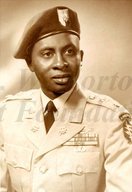
|

|
|
|
|
He was born in Atlanta, Texas, as the youngest of two brothers to Irving Cary, a delivery truck driver, and Gladys Howard Cole Cary. As a youngster Richard worked several jobs, including sales circular distribution, ticket taker at a movie theater, and carrier in the black community for the Shreveport Times. He graduated from what was then called the "colored" high school in 1942, and left Atlanta for Kansas, where a brother lived. He then moved to Ripley, California, where he worked as a welder at Kaiser Shipbuilding Company. Drafted in July of 1943, Richard was sent to Fort Leavenworth, Kansas, where he scored highly enough in examinations to enter officer training. Denied a chance to be an officer because of his skin color, he instead was sent to Camp Plauche near New Orleans. After basic and advanced individual training, ironically in welding, he was stationed in Newport News, Virginia. There a riot broke out when white airborne troops beat a black soldier for wearing jump boots. He sailed on a Liberty ship to Oran, North Africa. From there he took a British transport to Bombay, India, then traveled to Calcutta by train. He was placed as a security guard at an air force dump at Kanchrapara, north of Calcutta. From there he was sent to Burma and assigned to the 45th Engineer Regiment, an all-black unit. Ironically, his brother was serving in the 45th Quartermaster Regiment in Assam, India, where they enjoyed a brief reunion. Richard was sent to Shedaung, Burma to build a road from Assam to connect to the old Burma Road across the foothills of the Himalayas. He spent the rest of the war helping maintain a 50-mile stretch of that road, which the Japanese occasionally bombed. Richard was serving as a T4 (technician fourth class) while he ran the welding shop. He used his spare time to take college preparatory courses. Richard came home in March of 1946 and entered Wichita State University on the GI Bill, aiming for a career in dentistry. He joined ROTC, then received a regular commission to begin a long military career at duty stations in Asia, Europe, and America. In Korea he served as first lieutenant of a rifle platoon in combat with the 17th Infantry Regiment (also known as the 17th Infantry Buffalo Regiment) and as battalion adjutant. Returning to the States, Richard requested an intelligence assignment and was sent to Fort Holabird in Dundalk, Maryland, to intelligence school. He worked in Philadelphia as a special agent army counterintelligence officer and was promoted to captain. Because the FBI had no African-American field agents, he infiltrated black Muslim meetings. Returning to the infantry, he enrolled in a year-long leadership course at Fort Benning near Columbus, Georgia. While there he married Ida Walton of Phoenix City, Alabama, in December of 1958. They would have two children and two grandchildren. Richard served as executive officer of the Second Battalion of 39th Infantry of the Fourth Infantry Division. His unit trained in cold weather operations in Alaska, then in desert and amphibious training. He was sent to Germany as a G2 replacement for the 24th Infantry Division, and served as commander of a rifle company. Promoted to major in 1962, Richard served as commander of 705th Military Intelligence, a Special Forces unit, at Fort Bragg, North Carolina. By August of 1964 he was wearing a Special Forces Green Beret and serving in an intelligence unit at Tuy Hoa, South Vietnam. Returning to the States in 1965, he was as an intelligence instructor at Fort Holabird, while also earning a masters' degree from The Johns Hopkins University in Baltimore. Promoted to lieutenant colonel he commanded an imagery battalion in North Carolina. He made colonel while working as a joint staff officer in Washington. Richard returned to South Vietnam in 1972 as an intelligence adviser, but was back in Washington, D.C. a year later in U.S. Army Intelligence Threat and Analysis Detachment. After serving at Mors, Belgium in NATO headquarters, he retired in 1980 as a full colonel. As a civilian, he worked as a security officer for the B2 project with LTV Corporation in Dallas. |


